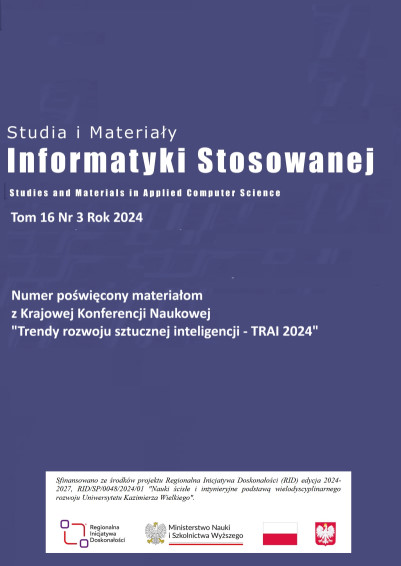Classification of EEG signals at brain-computer interfaces using neural networks
DOI:
https://doi.org/10.34767/SIMIS.2024.03.03Keywords:
Brain-computer interface, EEG, Neural networks, Signal classification, Signal processingAbstract
The aim of this paper is to present methods for classifying EEG signals in brain-computer interfaces (BCIs) using neural networks. Thanks to their ability to model complex relationships in the data, it is possible to recognise patterns of brain activity more effectively, which contributes to improving the accuracy and speed of BCI systems. This paper discusses neural network architectures used to analyse EEG signals, such as convolutional networks (CNNs) or recurrent networks (RNNs). The research shows that these methods have immense potential in applications such as assistive device control, communication, and entertainment.
References
Wosiak A., Dura A. Hybrid Method of Automated EEG Signals’ Selection Using Reversed Correlation Algorithm for Improved Classification of Emotions. Multidiscip Digit Publ Inst. 2020. doi: 10.3390/s20247083.
Berestov R.M., Bobkov E.A., Belov V.S., Nevedin A.V. Brain–computer interface technologies for monitoring and control of bionic systems. IOP Publ. 2021. doi: 10.1088/1742-6596/2058/1/012030.
Piszcz A. BCI w VR: imersja sposobem na sprawniejsze wykorzystywanie interfejsu mózg-komputer. Studia i Materiały Informatyki Stosowanej. 2021, 13(1), 5-10.
Jian C. et al. EEG-Based Cross-Subject Driver Drowsiness Recognition With an Interpretable CNN. 2022.
Emami A., Kunii N., Matsuo T., Shinozaki T., Kawai K., Takahashi H. Seizure detection by convolutional neural network-based analysis of scalp electroencephalography plot images. Elsevier BV. 2019.
Piszcz A., Rojek I., Mikołajewski D. Impact of Virtual Reality on Brain–Computer Interface Performance in IoT Control— Review of Current State of Knowledge. Multidiscip Digit Publ Inst. 2024. doi: 10.3390/app142210541.
Gu X. et al. EEG-Based Brain-Computer Interfaces (BCIs): A Survey of Recent Studies on Signal Sensing Technologies and Computational Intelligence Approaches and Their Applications. IEEE/ACM Trans Comput Biol Bioinform. 2021, 18(5), 1645. doi: 10.1109/tcbb.2021.3052811.
Luo W., Yin W., Liu Q., Qu Y. A hybrid brain-computer interface using motor imagery and SSVEP Based on convolutional neural network. 2023. doi: 10.1080/27706710.2023.2258938.
Ahmedt-Aristizabal D., Fookes C., Nguyen K., Sridharan S. Deep Classification of Epileptic Signals. 2018. doi: 10.1109/embc.2018.8512249.
El-Ashmawi W.H. et al. A Comprehensive Review on Brain-Computer Interface (BCI)-Based Machine and Deep Learning Algorithms for Stroke Rehabilitation. Multidiscip Digit Publ Inst. 2024, 14(14), 6347.
Zhang L, Xia B., Wang Y., Zhang W., Han Y. A Fine-Grained Approach for EEG-Based Emotion Recognition Using Clustering and Hybrid Deep Neural Networks. Multidiscip Digit Publ Inst. 2023.
Carrara I., Aristimunha B., Corsi M., de Camargo R.Y., Chevallier S., Papadopoulo T. Geometric Neural Network based on Phase Space for BCI decoding. Cornell University. 2024. doi: 10.48550/arxiv.2403.05645.
Ali O., Saif-ur-Rehman M., Dyck S., Glasmachers T., Iossifidis I., Klaes C. Enhancing the decoding accuracy of EEG signals by the introduction of anchored-STFT and adversarial data augmentation method. Nature Portfolio. 2022. doi: 10.1038/s41598-022-07992-w.
Downloads
Published
Issue
Section
License

This work is licensed under a Creative Commons Attribution-ShareAlike 4.0 International License.

